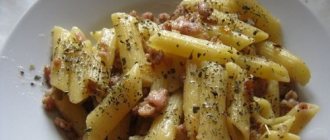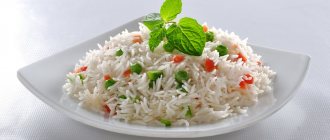How many calories:
=186 kcal.
There are 186 calories in Pilaf with Pork. per 100 grams.
100 grams of the product “Pilaf with Pork” contains:
- Pork - 28 g;
- Water - 27 g;
- White rice (weight before cooking) - 23 g;
- Carrots - 9 g;
- Onion - 9 g;
- Sunflower oil - 3 g;
- Butter - 1 g;
- Garlic - 1 g;
- Spices - less than 1 g;
The general recipe for preparing pilaf with pork, for which the calorie content is calculated, is as follows: Pork, onions and carrots are fried in sunflower oil (can be separately). Add fried foods, rice, water, salt and a piece of butter to a saucepan, stewpot or multicooker bowl (depending on the cooking method). During the stewing process, spices and garlic are added. The calorie content of pilaf may vary depending on the fat content of the pork. For this recipe, the average calorie content was taken (top fillet, carbonate).
Components and chemical composition of pilaf with pork
The dish prepared according to the classic recipe contains:
- rice;
- pork;
- carrot;
- onion;
- garlic;
- spices;
- vegetable oil.
Thanks to the large list of ingredients, pilaf contains most of the nutrients necessary for the body to function properly.
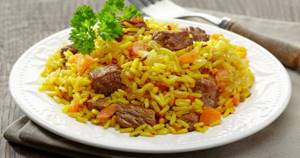
| Nutrient name | Percentage of the daily requirement for an adult. |
| Vitamin A | 2 % |
| Beta carotene | 2 % |
| Vitamin B1 | 7,5 % |
| Vitamin B2 | 1,8 % |
| Kholin | 3 % |
| Vitamin B5 | 2,9 % |
| Vitamin B6 | 5 % |
| Vitamin E | 6,7 % |
| Vitamin C | 1,3 % |
| Vitamin PP | 6,6 % |
| Potassium | 3,8 % |
| Calcium | 1,8 % |
| Magnesium | 2,6 % |
| Sodium | 20 % |
| Phosphorus | 5,5 % |
| Chlorine | 17 % |
| Iron | 3,2 % |
| Cobalt | 9,2 % |
The finished dish also contains vitamins B9 and K, and microelements (iodine, manganese, copper, molybdenum, selenium, fluorine, chromium, zinc).
For gourmets - beef
One of the varieties that is also recognized by Muslim “inventors” is pilaf with beef. If a pig is a dirty animal, then they do not protest against cows. There is even a special recipe called “Uzbek beef pilaf.” There are some peculiarities in cooking, but they are too significant. And at the same time, the calorie content of pilaf with beef is noticeably lower.
The main differences: the meat must be carefully cleaned of veins and films - that’s it. Second: after frying the zirvak, it needs to be stewed. Stewing will take from an hour (if you got veal) to two (if you found only the meat of an adult cow). And third: when everything is ready, the fire is extinguished, but the contents of the cauldron under the lid should be infused for at least half an hour. All these measures are aimed at removing the toughness of the meat. But the calorie content of pilaf with beef will be only 215 kcal, and if you take very lean pieces, it will drop to 200. For those concerned about their figure, this is a significant difference. If we compare the beef version and the calorie content of pilaf with pork, the numbers in the first case are very encouraging.
The benefits and harms of the dish
Pilaf with pork, despite its high calorie content, has a positive effect on the body. After eating the dish, a person retains a feeling of fullness and vigor for a long time. This effect is achieved due to the presence of proteins, as well as animal and vegetable fats.
Due to the high content of various vitamins, the product in question can improve the functioning of the body’s immune system, normalize the functioning of the cardiovascular system and visual organs. Since rice is a natural sorbent, the eaten dish allows you to remove waste and toxins from the body.
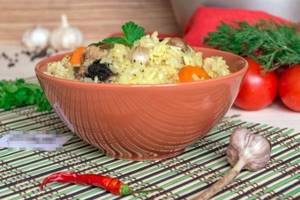
The presence of dietary fiber helps lower cholesterol levels, which makes consuming animal fats safer. The vegetables included in pilaf can improve the condition of the skin, hair and nail plates, and reduce the body’s susceptibility to viral diseases.
When consumed in moderation, the dish in question does not have a negative effect on the body, but it is not recommended to be included in the diet of obese individuals. Also, you should not include pilaf with pork in the diet of children of primary preschool age.
Nourishing but healthy
Pilaf is definitely not a dietary dish. Its nutritional value is so great that pilaf is enough for a full lunch. However, it cannot be called a harmful food, since all the ingredients contain elements necessary for a person. The main component - rice - is a carrier of a large amount of vitamins, microelements and minerals (among which the most valuable are iron and calcium), starch and fiber.
The importance of carrots and onions goes without saying. The orange vegetable is even used to prevent cancer, strengthen vision and immunity, and lower blood pressure.
Meat and fat increase the most. With pork it will be higher, with other types of meat it will be slightly lower, but this dish is still not suitable for those on a diet. At the same time, meat remains necessary: it supplies a person with the necessary proteins, mineral salts and some vitamins.
With all its increased nutritional value, pilaf is very easily digestible, so it can be eaten even by those who do not have very advanced digestive problems.
Contents of the BZHU
The table shows the average values of proteins, fats and carbohydrates per 100 g of finished dish:
| Name | Quantity |
| Squirrels | 8.81 g |
| Fats | 9.3 g |
| Carbohydrates | 21.47 g |
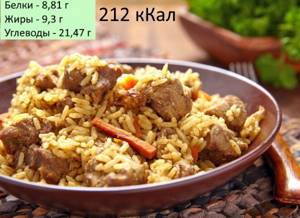
Calorie content and nutritional value of the dish. Depending on the ingredients used, the indicators may change up or down.
The most delicious option
And even though the calorie content of pilaf with pork is maximum, for us it remains the most attractive. The main thing when preparing it is to follow all the rules so that, despite its satiety, it is easily digestible and gives taste pleasure. Not making a mistake in spices is the first key to success. So don't forget cumin, paprika, turmeric, and be sure to find doorweed. The second component that will help you avoid failure is a well-made zirvak, that is, meat, overcooked with vegetables, cooked before adding rice. The main condition here is to cook it over high heat. The third rule is not to stir the rice so that the result is pilaf, and not porridge with meat.
There are a million recipes for this dish. But if you do everything listed above, they will turn out to be the right dish. And if you are only interested in the calorie content of pilaf with pork, then take care of selecting a part of the carcass. The average calorie content of pilaf with this meat is 285 kcal. If you take a fatty neck or add lard (lard), it will reach 300. And if you choose a relatively lean piece, and even if you cut off the fat layers, you will get pork pilaf, the calorie content of which will drop to 240-250 kcal.
Additional ingredients and their effect on the energy value of the dish
In addition to rice and meat, garlic, onions and carrots are added to the pilaf.
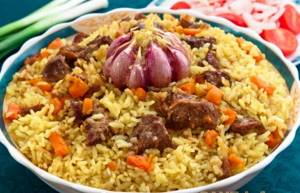
These products themselves have low energy value. Their quantity can both reduce and increase the number of kilocalories per 100 g of product.
Delicious recipes for pilaf with beef
Beef pilaf, the calorie content of which is approximate in the recipes, has many cooking options. It can be cooked in a cauldron, in a frying pan, in a saucepan, in pots or using a slow cooker. Also, when preparing pilaf with beef, you can experiment with different types of rice and ingredients - mushrooms, raisins, chickpeas.
In an Uzbek cauldron with mushrooms
In traditional recipes, lamb is used when preparing this dish, but even with beef, this dish turns out to be very aromatic and satisfying.
To prepare pilaf in a cauldron with mushrooms and beef, take:
- rice (basmati or devzir) – 1 kg;
- onion – 3-4 heads;
- carrots (preferably yellow) – 1 kg;

- garlic – 2 heads;
- beef – 1 kg;
- vegetable oil – 150 g;
- hot pepper – 1-2 pods;
- turmeric;
- cumin;
- salt.
First you need to prepare the products:
- Rinse all the rice thoroughly (the water should be clear).
- Cut the meat into medium-sized pieces.
- Peel the carrots and cut them into thin strips.
- Peel garlic and onions. Cut the onion into rings and leave the garlic whole.
Prepare the dish like this:
- Heat vegetable oil in a cauldron.
- After 5-7 minutes. Add a pinch of salt, cumin, turmeric and onion cut into rings to the oil and wait until it turns golden brown.
- Next, add the meat and fry for 10-12 minutes.
- After this, carrots are sent to the cauldron.
- After 10-15 minutes, add water, about 1 liter, to the cauldron and let it boil, after which hot pepper and garlic are added. Then turn down the heat and leave everything to simmer for 30 minutes.
- After 30 minutes, remove the pepper and garlic onto a separate plate, and add the washed rice to the water, increasing the heat before doing so.
- Using a slotted spoon, level the rice over the entire surface and reduce the heat again. You cannot mix it with meat and vegetables; it must be gradually soaked in the resulting sauce. The finished rice should be firm and crumbly, but not hard in taste.
- Before turning off, make a depression in the center of the dish in the cauldron using a spoon and place the previously laid out garlic and pepper into it.
- After turning off the pilaf, cover it with a lid and a towel and let it stand for 15-20 minutes.
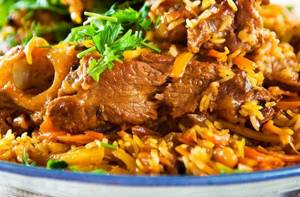
The calorie content of finished pilaf with beef is about 250 kcal, while the calorie content of pilaf with lamb will be slightly higher - 297 kcal per 100 g.
In a saucepan on the stove with steamed rice and barberries
You can prepare delicious pilaf not only in a cauldron, but also in an ordinary pan.
To do this take:
- 400 g rice (parboiled);
- 500 g meat;
- 300 g carrots;
- 250 g onions;
- 2 heads of garlic;
- 0.95 l of water;
- 100-150 ml vegetable oil;
- spices to taste:
- salt;
- barberry;
- turmeric;
- khmeli-suneli;
- pepper.
Prepare the dish like this:
- The meat is washed, cut into not too large pieces and sprinkled with spices.
- Pour oil into a thick-bottomed pan and let it heat over medium heat.
- Peeled onions are cut into half rings and sent into heated oil along with the prepared meat.
- While the onions and meat are stewing, the peeled carrots should be cut into thin strips. After 15-20 minutes. the meat and onions are covered with prepared carrots and spices are added (barberry, suneli hops, pepper, salt, turmeric). Simmer everything together over low heat for about 20 minutes.
- After 20 min. Add washed rice to vegetables and meat, pour 3.5 cups of boiled water over it and level it.
- Cover the pan with a lid, turn up the heat and simmer until all the liquid has evaporated, about 10 minutes.
- After this, the fire is reduced, and the rice is pierced in several places with a wooden stick and simmered for about another 5-7 minutes.
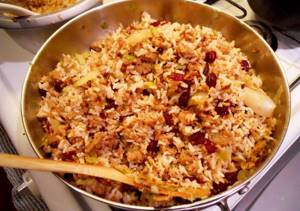
The calorie content of pilaf with barberry cooked in a pan is 265 kcal.
With brown rice in a frying pan
In addition to cauldrons and saucepans, thick frying pans with high sides are also suitable for preparing pilaf.
To prepare pilaf with beef and brown rice, which is not only very healthy, but also lower in calories compared to other types, you will need:
- beef meat (fillet) – 0.5 kg;
- onions – 2-3 pcs.;
- carrots – 2-3 pcs.;
- sunflower oil – 150-200 ml;
- turmeric;
- cumin;
- peppercorns;
- head of garlic;
- salt;
- ground black and red pepper.
- brown rice – 300 g.
The brown type of rice is very healthy, but it does not boil well and therefore the pilaf from it always turns out crumbly.
Pilaf is prepared from this rice as follows:
- The rice is pre-washed several times.
- The meat is also washed and cut into small pieces.
- Then peel and cut the onion (you can use half rings, rings or just cubes).
- Peeled carrots are chopped into strips.
- The husk is removed from the head of garlic, but not completely removed.
- Then pour oil into a frying pan with a thick bottom and heat it thoroughly.
- Place the meat in the heated oil and fry, stirring until all the liquid has evaporated.
- After this, add the onion to the meat and lightly fry it for 5-7 minutes.
- After 5-7 minutes. carrots are added to the frying pan.
- After the carrots are fried, pour water into the frying pan so that it is 2-3 cm higher than all the products and cook everything for about 30 minutes, covering with a lid. During this time, zirvak is formed - it is this that will give the coarse brown rice its main taste. At the end of cooking, add turmeric, salt and pepper to the zirvak.
- Next, add the rice in an even layer, without mixing it with the meat and vegetables, add water and simmer the pilaf for another 1 hour over low heat.
- 10-15 minutes before readiness, add a head of garlic to the pilaf.
- After turning off the pilaf, cover it with a plate and a lid on top so that the brown rice is completely saturated with zirvak.
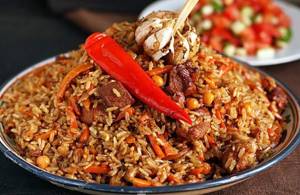
The calorie content of finished pilaf with brown rice is approximately 135 kcal per 100 g.
With chickpeas and raisins in layers in a slow cooker
You can prepare crumbly and tasty pilaf in a slow cooker.
To prepare an unusual pilaf with raisins and chickpeas you will need:
- vegetable oil – 150 ml;
- water – 360 ml;
- raisins – 30 g;
- onions – 2-3 pcs.;
- meat (beef fillet) – 500-600 g;
- carrots – 600-700 g;
- garlic – 2 heads;
- rice – 400-500 g;
- chickpeas (round peas) – 200 g;
- raisins (yellow) – 100 g;
- spices:
- cumin;
- curry;
- turmeric;
- salt.
Prepare this dish in a slow cooker as follows:
- The chickpeas are pre-soaked for at least 5-6 hours or overnight and then boiled for about 40 minutes.
- For zirvak, vegetables are prepared - they are peeled and the carrots are cut into thin strips and the onion into half rings.
- Rice and raisins are thoroughly washed and filled with boiled hot water in different containers.
- Pour oil into the multicooker bowl, add onion and chopped meat. In the multicooker menu, select the “Baking” mode and set the time for 20 minutes.
- After 20 min. cumin, curry and turmeric are added to the vegetables and onions, carrots are poured on top and the vegetables are included again and the meat is cooked for another 20 minutes. Do not mix the ingredients in the slow cooker after adding carrots.
- In 20 minutes. Place boiled chickpeas and raisins on top of the carrots and insert a whole head of garlic into the carrots (the husks should not be completely peeled), and pour washed rice on top and pour boiled water over the entire dish. In this form, the dish is cooked on the “Pilaf” mode for 50-60 minutes.
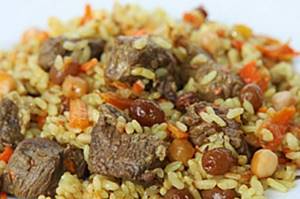
The calorie content in such pilaf will be quite high due to the abundance of protein, which chickpeas and meat are rich in, and will be about 330 kcal per 100 g.
In the oven in pots with bulgur
Bulgur is steamed, crushed and dried cereal grains made from shelled wheat. It goes well with various types of meat, including beef.
To prepare bulgur pilaf with beef in pots, you need the following ingredients (for 3-4 pots):
- lean beef – 400 g;
- bulgur – 150 g;
- onion – 100 g;
- carrots – 350 g;
- olive oil – 15 g;
- salt;
- pepper
- water – 250 ml.
Cooking such pilaf in pots is not at all difficult:
- Vegetable (olive) oil is poured into each pot.
- Cut onions and carrots into medium-sized cubes (carrots can also be cut into short strips), add pepper and salt, and place them on the bottom of the pots;
- The meat is washed, cut into pieces and placed on top of the vegetables, distributing approximately equally in each pot.
- The cereal is washed and placed on top of the meat, leveling it on top, and seasoned with salt.
- Boiled water is poured into each pot so that it is 1-1.5 cm above the cereal layer and placed in the oven for 45-50 minutes at 180C.
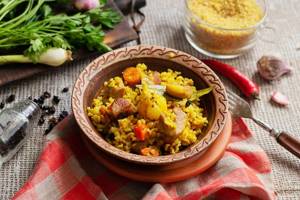
The calorie content of the finished dish is low - 120 kcal per 100 g.
With boiled meat for a diet menu
Another option for preparing dietary pilaf is a method in which the meat is pre-boiled.
For preparation take:
- beef – 500-600 g;
- onions – 1-2 pcs.;
- carrots – 2 pcs.;
- rice (long grain) – 250 g;
- olive oil – 2-3 tbsp;
- salt.
In fact, all the components of dietary pilaf are identical to the usual version, the difference lies in the method of preparing the meat, the exclusion of spices and the replacement of fatty sunflower oil with olive oil.
Pilaf is prepared like this:
- The beef is boiled and cut into pieces.
- In a frying pan, fry chopped onions and grated carrots in olive oil.
- The rice is washed and placed in a frying pan, spreading it evenly on top of the vegetables. Fill everything with water so that it is 1.5-2 cm higher than the rice.
- Rice and vegetables are stewed for 40-45 minutes. Before serving, add meat to the rice.
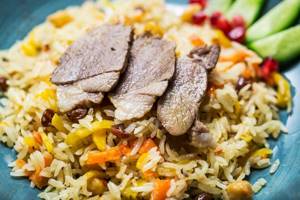
The calorie content of such pilaf will be approximately 180 kcal per 100 g.
With Shirataki rice according to Dukan's recipe
Shirataki rice is a natural plant product that contains a large amount of dietary fiber and is characterized by an almost complete absence of calories. Pilaf with beef and rice of this variety turns out to be very light, but at the same time appetizing.
For preparation take:
- shirataki rice – 200 g;
- lean beef – 350-400 g;
- onion – 1 pc.;
- carrots – 1 pc.;
- tomato paste – 1 tsp.
Pilaf is prepared like this:
- The meat is cut into pieces and stewed in tomato paste for about 10 minutes.
- Then carrots and onions cut into thin strips are added to the meat, and rice is added. Simmer everything for 25-30 minutes.

Stewing makes the rice tasty and soft. The calorie content of the finished dish is approximately 86 kcal per 100 g.
There are many options for preparing pilaf. Among the variety of recipes, people who want to lose weight can easily choose the appropriate way to prepare this delicious dish. One such way is to prepare this dish with beef.
Its calorie content will be lower than that of traditional pilaf with lamb or pork, which will help maintain normal weight and provide a satisfying and varied diet.
How to reduce the calorie content of pilaf?
To reduce the calorie content of pilaf with pork:
- It is necessary to choose the right meat products. It is advisable to use fillet parts without lard. When using a neck piece, it is recommended to trim off the fat. Thus, the energy value of the dish can be reduced to 250 kcal per 100 g of product.
- You should choose fats with lower calorie content. It is recommended to avoid adding animal fats and replace vegetable oil with olive oil. In addition to changing the type of product, it is necessary to reduce its quantity to obtain maximum results.
- It is recommended to select a suitable cooking method. When preparing pilaf in a slow cooker or steamed, the use of fat can be practically eliminated, which allows reducing the energy value of the dish by an average of 50 kcal.
- It is necessary to change the proportions of the main components and vegetables. By reducing the amount of pork and adding more vegetables, you can significantly reduce the number of calories in the dish. To ensure that the taste of the pilaf does not suffer from a lack of protein components, you can include porcini mushrooms, which have a low calorie content, in the recipe.
- You can replace white rice with brown rice. With such a substitution of products, you can reduce the number of kilocalories by 1/5.
By following the suggested recommendations, you can prepare a dietary dish, even using pork in the composition.
Benefit for health
Previously, pilaf was considered a festive treat. The recipes used rice, mung bean, peas and minced meat. We mixed it all with a lot of onions, carrots and garlic. The dish was cooked over an open fire and a lot of oil was added.
Nowadays, any meat, fish, seafood or vegetables are used to prepare pilaf. The cereal part of the dish is not only rice, but also other cereals (bulgur, millet), as well as legumes (chickpeas, mung beans, lentils). Mandatory seasonings: cumin, barberry, hot red pepper. Without these spices, you will just end up with rice porridge with meat.
In addition to its unsurpassed taste, pilaf is also good for health:
- Grain is well absorbed by the body, especially if rice was used during cooking.
- Meat provides the body with animal protein.
- Amino acids in the dish help with stress, depression, and insomnia.
- Carrots are rich in vitamin A, which is essential for cell growth and development.
- Onions contain vitamin C, enhance the production of gastric juice and promote rapid digestion of food.
In general, eating pilaf has a beneficial effect on the functioning of the digestive tract; dietary recipes are indicated for chronic diseases of the esophagus.
Vegetable fantasies
Concerns about excess weight have given rise to many recipes in which meat is not involved, but pilaf is present. You want something tasty, but you have to limit yourself. So variants of zucchini and eggplant pilaf have been invented; the same dish with dried apples and carrots, apple-nettle modification; pilaf with sweet pepper or lemon. This is not to say that these are too successful replacements. For example, eggplant instead of meat will not reduce nutritional value: such pilaf is comparable to our favorite, pork (287 kcal). Eggplant is comparable to the beef version - the same 214 kcal. Except that apples, nettles and bell peppers are quite consistent with the diet: from 86 to 165 kcal. But the taste is vegetarian!
And a little about secrets...
The story of one of our readers, Inga Eremina:
I was especially depressed by my weight; at 41, I weighed as much as 3 sumo wrestlers combined, namely 92 kg. How to completely lose excess weight? How to cope with hormonal changes and obesity? But nothing disfigures or makes a person look younger than his figure.
But what can you do to lose weight? Laser liposuction surgery? I found out - no less than 5 thousand dollars. Hardware procedures - LPG massage, cavitation, RF lifting, myostimulation? A little more affordable - the course costs from 80 thousand rubles with a nutritionist consultant. You can, of course, try to run on a treadmill until you go crazy.
And when will you find time for all this? And it's still very expensive. Especially now. Therefore, I chose a different method for myself...
The most dietary pilaf
It all depends primarily on what “filling” you choose for your dish. If you are leaning towards the meat option, the least nutritious and dietary option will be chicken. Yes, even if you resort to modern kitchen appliances. So, chicken in this dish, prepared traditionally, will give the dish about 170 kcal, if you get a lean bird or take chicken. A pilaf prepared from the same chicken in a slow cooker will have no more than 140 calories. The beef variety will lose about 50 kcal out of 215, and the pork variety will lose the same amount. A minimum of 165 kcal will remain, but if you compare them with 220 or 280, those losing weight will immediately have to run to the store for a multicooker.
And if you choose pilaf without meat, and even low-calorie, then you should stop at the nettle-apple variation. It will bring you only 86 kcal - compared to all other recipes, this is a record. The second place is occupied by dried apples, “diluted” with carrots - they reach 126. A proud third place goes to bell peppers with its 165 kcal. Other vegetables are inferior in energy content even to chicken, so from a dietary point of view they are unlikely to contribute to weight loss.
As you can see, pilaf varies in taste and composition. Choose what suits you and do not deny yourself the pleasure of this dish, even if you are on a diet.
Pilaf is a nutritious dish with a high calorie content. It is not recommended for use by those who are watching their figure. For example, the calorie content of a dish with beef is 218 kilocalories, with pork - 204 kilocalories. You can reduce the nutritional value of pilaf if you cook it with vegetables, but without using meat. In this case, its calorie content will be about 70 kilocalories. The nutritional value of pilaf with beans is 84 kilocalories, with tomatoes and bell peppers - 95 kilocalories. It is allowed to prepare a dish with seafood, for example, the calorie content with shrimp is 102 kilocalories.
IT IS IMPORTANT TO KNOW! Fortune teller Baba Nina:
“There will always be plenty of money if you put it under your pillow...” Read more >>
